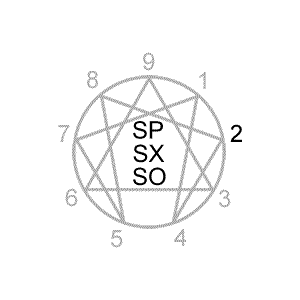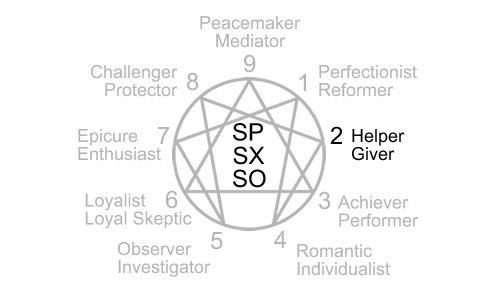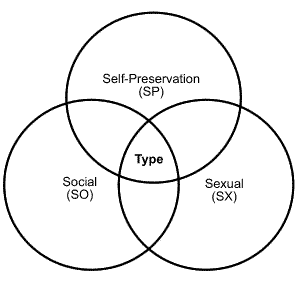Enneagram Type 2 Instinctual Subtypes: SP 2, SX 2, SO 2
The core focus of Enneagram type 2

Loneliness and the feeling of being unwanted is the most terrible poverty.
- Mother Teresa
Early in life we develop an initial belief about ourselves and a compensation for that self-belief.
-
Type 2 Initial Self-Belief: “I am unappreciated as I am.”
Type 2 Compensation: "I must find appreciation from and connection to people by responding to their needs and desires."
Over time this gets generalized beyond the self into a core focus that also shapes how we perceive and interact with the world at large.
-
Type 2 Core Focus: Appreciation comes from responding to the emotional needs and desires of others. This requires that I read their unspoken emotional cues in order to find a way to connect to and support them. From this I also find my role in the world and others' lives.
Personality characteristics that might arise from the type 2 core focus include:
- Represses own needs in service of others' needs
- Desires to be liked and important in the lives of others
- Shifts image to become what others desire or need
- Gets their own needs met by meeting the needs of others
- Emotionally seduces others to bring them closer
- Feels more comfortable giving than receiving
- Pays attention to emotional cues more than verbal content
- Thinks they know your needs better than you do yourself
- Unconsciously expects something in return for what they give
Enneagram type 2 instinctual subtypes

The Enneagram instincts are self-preservation (sp), sexual (sx), and social (so). The sexual (sx) instinct is also called the intimate or one-to-one instinct.
The instincts are traditionally used to define three instinctual subtypes or variations of a basic type (e.g., SP 2, SX 2, and SO 2). One of these three subtypes is called the counter-type because it can look different from the basic type.
Below are brief descriptions of the three type 2 instinctual subtypes.
SP 2 - Privilege, Me First (counter-type): child-like seduction in order to get for themselves what they need; exaggerated sense of entitlement or privilege; wants to be taken care of but doesn’t want to be dependent.
SX 2 - Seduction, Aggression: seduces or pulls others into close connection and relationship; looks to others to get what they want; aggressive through emotional seduction and manipulation in relationships.
SO 2 - Ambition: wants to lead, stand out, have influence and advantages; promotes themselves through association with people of status and influence; generosity is used strategically to influence and gain advantage.
While an individual may be identified with type 2 in general, that same individual may be more specifically identified with one of the three instinctual subtypes as well.
A more recent approach to using the instincts is instinctual variant stacking which can be used independent of Enneagram type.
What Enneagram authors say about type 2 instinctual subtypes

Below are Enneagram 2 subtype description samplings from some popular or well-known Enneagram authors. Click on the sources after the descriptions to further explore these interpretations.
-
In the average range, Self-Preservation Twos repress their own Self-Preservation instincts while focusing on taking care of the needs of others.1
In the average range, Sexual Twos are driven to get closer to others, both emotionally and physically.1
In the average range, Social Twos express a powerful desire to be liked and approved by everyone in their social sphere.1
-
Me-First (Privilege) in the Area of Self-preservation: There’s not going to be enough left for me once the others get what they want, and you get so angry at the indignity of being left out that you maneuver yourself to the head of the line.2
Seduction/Aggression in the One-to-One Relationship: Seduction is based on the preoccupation with being wanted as a sign of approval and entails drawing another to the self. Aggression is the confrontational overcoming of all obstacles to a relationship and means pushing for contact.2
Ambition in Social Situations: Ambition involves association with powerful people as a source of protection and as an assurance of status within the group.2
-
Self-Preservation Twos: Often harbor a striking sense of entitlement. May act superior to others and expect preferential treatment that reinforces their pride.3
Intimate Twos: Tend to act seductive and aggressive by turns. Generally confuse sexual desirability with being loved and valued.3
Social Twos: Notable for their ambition, particularly to be publicly recognized as someone special. Seek attention either directly from their own efforts or via affiliation with powerful people.3
-
Self-Preservation Type 2 by Beatrice Chestnut
Social Type 2 by Beatrice Chestnut
Sexual Type 2 by Beatrice Chestnut
Self-Preservation Two: "Privilege"
"Seduces" like a child in the presence of grown-ups as a way of unconsciously inducing others to take care of them. The title "Privilege" reflects this this Two’s desire to be loved and prioritized just for being who they are, not for what they give to others.4Sexual Two: "Seduction/Aggression"
Seduces specific individuals as a way of getting needs met and feeding their pride. The name "Aggressive-Seductive" suggests a character who is appealing, but who also wants to wield some power.4Social Two: "Ambition"
A seducer of environments and groups--a powerful, leader type whose pride manifests as a sense of satisfaction in the conquest of an audience. The name "Ambition" reflects this person’s desire to "be on top," and as a result of this lofty position, receive advantages and benefits.4
Sources
1Book: The Wisdom of the Enneagram; Website: The Enneagram Institute
2Book: The Enneagram; Website: The Narrative Enneagram
4Book: The Complete Enneagram; Website: Chestnut Paes Enneagram Academy
To learn more about the instincts click on a link below.
Enneagram Tests to Help Determine Instinct

There are two approaches to using the Enneagram personality instincts.
The instinctual subtypes describe three variations of each of the Enneagram types: a self-preservation (sp), sexual (sx), and social (so) subtype.
Instinctual variant stacking can be used with or without reference to Enneagram type by determining an individual's preferential order for the the three instincts (i.e., sp/sx, sx/sp, sp/so, so/sp, sx/so, or so/sx).
-
Instinctual Subtype Test
This test compares the three instinctual subtypes for a given type.
Use when you know your type and want to find your instinctual subtype for that type. -
Instinctual Variant Stacking Test
This test ranks the three instincts to determine your preferential order of the instincts.
Use when you want to know your instinctual variant stacking independent of type.
To learn more about Enneagram personality type 2 click here.
Click here for the Complete Guide to the Enneagram.
This free guide explains- the nine Enneagram personality types
- the many type variations within type
- where the types came from (origins and history)
- how the types use the Enneagram symbol
Click here for Enneagram tests.
These free tests help you find your- primary type
- candidate types
- preferred wing
- intinctual subtype
- instinctual variant stacking
- center types (gut, heart, and head)
- tri-center with wings